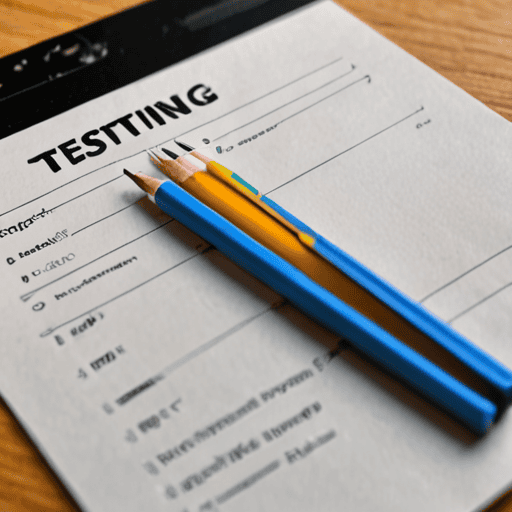Testing 1, 2, 3… Is this thing on?

1. Introduction
Testing is an essential part of any software development process. It is a process of evaluating the software or a product against the expected requirements or specifications. Testing is crucial to ensure that

2. Types of testing
There are many different types of testing that can be performed on a product or service. Some of the most common include functional testing, security testing, performance testing, and usability testing. Functional testing involves ensuring that the basic functions of the product work as intended. Security testing is focused on identifying vulnerabilities in the product that could be exploited by attackers. Performance testing measures the speed and reliability of the product under various loads. Usability testing evaluates how easy the product is to use and whether it meets the needs of its intended users. Other types of testing include stress testing, load testing, and regression testing. It’s important to choose the right type of testing for each product or service to ensure that all potential issues are identified and addressed before release.

3. How to test
To ensure that your product or service is functioning as intended, it is essential to perform thorough testing. Here are some tips and best practices to keep in mind when testing:
1. Start with small, manageable tests: Begin by testing individual components or features of your product to identify any issues early on. This will allow you to address these problems before they become more significant and time-consuming to fix.
2. Use various testing methods: In addition to manual testing, consider incorporating automated testing using specialized software tools. Automation can help speed up the testing process and reduce the likelihood of human error.
3. Test under different conditions: Ensure that your product performs well in a variety of scenarios, such as different devices, browsers, and network environments. This will give you a better understanding of its overall functionality and reliability.
4. Prioritize edge cases: Test your product under extreme conditions, such as with large amounts of data or high traffic, to identify potential performance issues.
5. Collaborate with users: User feedback is invaluable in identifying areas for improvement. Encourage users to provide feedback on their experience with your product, and use this information to refine your testing processes.
By following these best practices, you can streamline your testing process and increase the chances of delivering a high-quality product or service.

4. Common mistakes to avoid
When it comes to testing, there are many common mistakes that people make. Here are some of the most common ones to avoid:
1. Not testing enough: One of the biggest mistakes people make is not testing their product or service enough. This can lead to serious issues down the line, such as bugs, crashes, or security vulnerabilities. To avoid this mistake, make sure you have a comprehensive testing plan in place and stick to it.
2. Skipping manual testing: While automated testing is important, it’s also crucial to perform manual testing. Automated tests can miss certain edge cases or scenarios that require human observation and interaction. Make sure to include both automated and manual testing in your testing strategy.
3. Neglecting security testing: Security should always be a top priority when testing. Don’t neglect security testing, as it can leave your product vulnerable to hackers and cyber attacks. Include security testing in your testing plan and make sure to simulate real-world attack scenarios.
4. Ignoring user feedback: User feedback is essential for improving your product or service. Don’t ignore user feedback during the testing phase, as it can help you identify issues and areas for improvement. Incorporate user feedback into your testing process and use it to inform future iterations of your product.

5. Tools for testing
Tools for testing are essential for any company or individual looking to ensure the quality of their product or service. There are many different tools available, each with its own unique features and capabilities. Here are some popular options:
1. JMeter: This is a popular open-source tool for load testing. It allows users to simulate heavy traffic loads on their website or application, helping them identify performance issues and bottlenecks.
2. Selenium: This is a suite of tools for automated testing of software applications. It includes a browser driver for web browsers like Chrome, Firefox, and Safari, as well as a variety of plugins and extensions for specific testing needs.
3. Appium: This is an open-source tool for mobile app testing. It allows users to write tests in multiple programming languages, including Java, Ruby, and Python.
4. LoadRunner: This is a commercial tool for load testing, developed by Micro Focus. It allows users to simulate high levels of traffic on their website or application, helping them identify performance issues and bottlenecks.
5. Postman: This is a popular tool for API testing. It allows users to send HTTP requests and receive responses, making it easy to test APIs and ensure they are functioning properly.
These are just a few examples of the many tools available for testing. When choosing a tool, it’s important to consider factors such as the type of testing being done, the size and complexity of the project, and the budget available. By using the right tools, companies and individuals can ensure the quality of their products and services, and provide a better experience for their customers.

6. Examples of successful testing
In this section, we will explore some examples of companies or products that have successfully tested their products. By examining these examples, we can gain insight into the importance of testing and the benefits it can bring.
One example of a company that has successfully tested its product is Apple. When the iPhone was first released, it underwent extensive testing to ensure that it was reliable and user-friendly. This included functional testing, security testing, and performance testing. As a result of these tests, the iPhone was able to meet the high standards set by Apple and became a popular and successful product.
Another example of a product that has been successfully tested is NASA’s Mars Rover. Before the Rover was sent to Mars, it underwent rigorous testing to ensure that it could withstand the harsh conditions of the Martian environment. This included tests for durability, reliability, and functionality. Thanks to these tests, the Mars Rover was able to successfully navigate the Martian terrain and gather valuable data about the planet’s geology and atmosphere.
These examples demonstrate the importance of testing in ensuring the quality and success of a product. By thoroughly testing a product, companies and organizations can identify and fix any issues before they become major problems, leading to increased customer satisfaction and improved brand reputation.

7. The importance of user feedback
User feedback is crucial in the testing process as it helps identify areas where the product or service may not meet the user’s expectations or needs. By incorporating user feedback into the testing process, businesses can ensure that their products are user-friendly and effective. Additionally, user feedback can help identify potential issues before they become major problems, saving time and resources in the long run. It is important for businesses to actively seek out and incorporate user feedback into their testing process to ensure the success of their products or services.

8. Conclusion
Testing is a crucial part of any software development process, and it’s essential to get it right. By following best practices and avoiding common mistakes, you can ensure that your product is reliable and meets the needs of your users. Remember to always seek user feedback and use it to improve your testing processes. With the right approach, testing can be a rewarding and enjoyable experience.

0 Comments